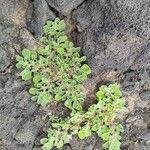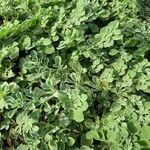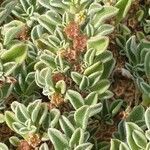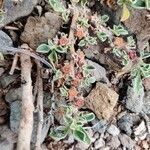Herb, up to 0.4 m high, prostrate annual or short-lived perennial; stems and leaves covered with stiff, spreading hairs. Leaves alternate, oval or spathulate, margins entire; petioles as long as or longer than blade. Flowers bisexual, sessile, in flattened axillary clusters. Perianth 5-lobed, yellowish inside, greenish or reddish and pilose outside; sepals small, upcurving. Stamens 12-15 in bundles. Ovary 5-locular; styles and stigmas 5. Fruit a pentagonal capsule, red or pink, depressed centrally, split into 5 valves. Seeds reniform, concentrically ridged, dark brown.
Perennial herb, up to 0.4 m high; many stemmed. Stems decumbent. Leaves alternate; papulose; blade suborbicular to narrowly obovate to obovate, 8-70 x 4-45 mm, apex obtuse, at base narrowed to a petiole as long as blade or longer. Flowers: solitary in leaf axils; perianth with outer surface pilose, yellowish inside, greenish or reddish outside; Sep.-Jun. Fruit 5-9 mm in diameter, persistent on dead plants for a long time.
A herb that lies along the ground. It can re-grow each year or continue to grow from year to year. The small branches are zig-zag. The leaves are hairy and taper to a short leaf stalk. The leaves are oval or spoon shaped and alternate. The edges of the leaves curl slightly upwards. The flowers are star shaped. They are in the axils of leaves and the forks of branches. The flowers are 3-8 mm across and do not have stalks.
A prostrate, often rather thick and many-stemmed annual or perennial herb. Leaves alternate. Lamina, 8-70 x 4-45 mm, suborbicular to oblanceolate-obovate, usually rounded at apex. Flowers solitary in leaf axils. Fruit 5-9 mm in diameter. Perianth yellowish inside, greenish or reddish and pilose outside.
Prostrate annual or short-lived perennial, up to 400 mm long, shortly hairy when young. Leaves spathulate or oval, narrowing into a petiole 3-18 mm long, blades 10-50 x 4-15 mm, adpressed-hairy. Flowers sessile in flattened, axillary clusters, yellow-green inside. Fruit 5-9 mm diam.
Flowers apparently axillary. Prostrate, annual or short-lived perennial to 30 cm, shortly hairy when young. Leaves pseudopetiolate, oblanceolate-spathulate, adpressed-hairy. Flowers sessile in flattened, axillary clusters, yellow-green, sepals small, upcurving.
Leaves alternate, leaf-lamina 8–70 × 4–45 mm., suborbicular to oblanceolate-obovate, rounded or bluntly subacuminate at apex, decurrent into the petiole at base, ± pilose on both sides, entire, with petiole 3–18 mm. long.
Fruit 5–9 mm. in diameter, usually red or pink, pentagonal, stellate, depressed centrally, splitting into 5 valves, these inflexed and remaining attached to the centre of the ovary.
Perianth segments 5, c. 3 mm. long, triangular, acute, yellowish inside, greenish or reddish and pilose outside.
Stamens c. 12–15, inserted on calyx-tube in fascicles at the base of the sinuses between calyx-lobes.
Flowers solitary in leaf-axils or in forks of the branches, sessile, often numerous.
A prostrate often rather thick and many-stemmed annual or perennial herb.
Stem up to c. 40 cm. long, pilose, often also finely papillose.
Ovary 5-locular; styles 5, short; stigmas 5.
Seeds ?, reniform, concentrically ridged.









